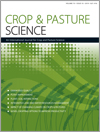The chlorina mutant can be exploited in photosynthesis and plant development research, but none of the chlorina mutant genes have been cloned in wheat. In the present study, the chlorina mutant gene Cn-A1 in wheat was mapped and a probable candidate gene was identified. These results are expected to accelerate the process of cloning the cn-A1 gene and facilitate understanding of the mechanisms underlying chlorophyll metabolism and chloroplast development in wheat.

Crop and Pasture Science
Volume 70 Number 10 2019
CP19111Assessment of synthetic hexaploid wheats in response to heat stress and leaf rust infection for the improvement of wheat production

Bread wheat remains one of the primary cereal crops grown worldwide; however, its narrow genetic diversity threatens the sustainability of wheat production for future consumption. Therefore, synthetic hexaploid wheat was artificially created to provide a promising source of novel genetic diversity to help plants gain tolerance to stresses. We found out that our synthetic wheats can tolerate heat stress and leaf rust infection, and these traits could be used in breeding stock to develop local cultivars.
Rice is one of the most important food crops worldwide. In this study we found that a greater photosynthetic electron flow was distributed to Rubisco-dependent carboxylation by increasing the endogenous ascorbic acid content, and this increased rice yield. Increasing ascorbic acid content in crop leaves is a good way to increase crop yield.
CP19164Nutrients management and planting time adaptation to climate change for wet season rice production in subtropical India
A field experiment was conducted to evaluate nutrients management and plating time as adaptations to climate change for wet season rice production under rainfed ecosystem of subtropical India. A well validated location specific management option for climate change adaptation in rice production system is lacking. Keeping this in mind, we conducted this experiment and we observed that, increasing dose of integrated nutrients and early planting is expected to minimise the adverse impact of climate change on rice production of the subtropical India.
CP19298Development and validation of breeder-friendly functional markers of sugary1 gene encoding starch-debranching enzyme affecting kernel sweetness in maize (Zea mays)
 , Vignesh Muthusamy, Aanchal Baveja, Brijesh K. Mehta and Rajkumar U. Zunjare
, Vignesh Muthusamy, Aanchal Baveja, Brijesh K. Mehta and Rajkumar U. Zunjare
The sweet corn variety of maize, governed by the recessive su1 gene, is an important source of livelihood for farmers and generates foreign exchange; however, existing markers of su1 gene sometime lead to faulty selection of su1 gene in the breeding program, resulting in loss of time and resources. Here, we have developed and validated new markers that are fully reliable for selection of su1. These new markers will help in accelerating the development of new sweet corn hybrids, thereby increasing farm incomes.
CP19015Cytological identification of new-type Brassica napus materials and their physiological response to drought
 , Zuqing Meng, Tao Luo, Jiajia Xin, Mengzhu Xian, Na Rao, Quan Chen, Yuhao Wang, Mohammad Nauman Khan and Liyong Hu
, Zuqing Meng, Tao Luo, Jiajia Xin, Mengzhu Xian, Na Rao, Quan Chen, Yuhao Wang, Mohammad Nauman Khan and Liyong Hu
Drought being one of the most influential abiotic stress factors affecting crop yield, we examined improvement in drought resistance in Brassica napus by distant hybridisation between B. juncea and B. napus. The results indicated broadened genetic diversity of the new-type B. napus with regard to drought resistance; a drought-resistant line may have a better ROS-scavenging system with a less extreme reaction to drought stress than that of drought-susceptible lines. These results provided new insights on the physiological mechanisms of drought resistance and new evidence supporting the breeding of drought-resistant B. napus via distant hybridisation.
CP19199Potential role of seed treatments in the management of emerging arthropod pests of canola
Food crops are attacked by a range of arthropods, with a few species recently emerging and causing problems for farmers. This work reports on a control strategy not previously considered for three pest species in Australia. A new management approach has potential to curb crop damage and reduce pest numbers, but this is influenced by the complexity of species and the treatments available.
CP19076Associative diazotrophic bacteria from forage grasses in the Brazilian semi-arid region are effective plant growth promoters
This study examined the ability of beneficial bacteria to stimulate plant growth of field-grown forage grasses in the Brazilian semi-arid region. We obtained 21 different bacteria that showed variability regarding the taxonomy, metabolism and plant growth-promotion ability. Among these, at least seven isolates can be tested for suitability as inoculants for forage grass production in drylands of Brazil and abroad.
CP19224Relationship between soil apparent electrical conductivity and forage yield in temperate pastures according to nitrogen availability and growing season
The present study has established that forage yield and response to nitrogen fertiliser are related to the soil apparent electrical conductivity (ECa). Therefore, ECa can be used to delimit environments with different productivities in temperate pastures. These results are the first step in developing algorithms for prediction of nutrient-application rates in environments of different potential at the paddock level.



